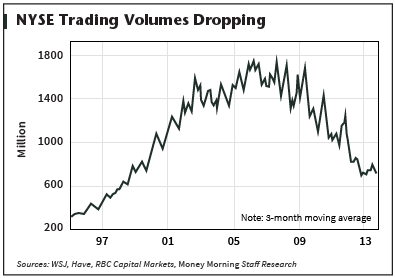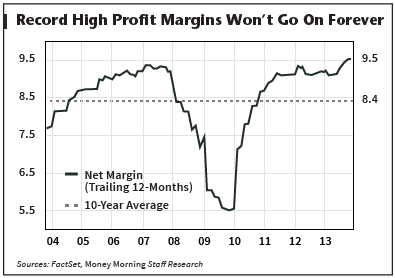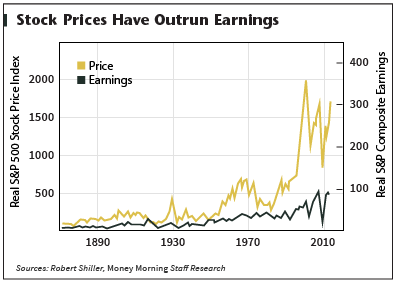DELAFIELD, Wis. (Stockpickr) -- Professional traders running mutual funds and hedge funds don't just look at a stock's price moves; they also track big changes in volume activity. Often when above-average volume moves into an equity, it precedes a large spike in volatility.
>>5 Stocks With Big Insider Buying
Major moves in volume can signal unusual activity, such as insider buying or selling -- or buying or selling by "superinvestors."
Unusual volume can also be a major signal that hedge funds and momentum traders are piling into a stock ahead of a catalyst. These types of traders like to get in well before a large spike, so it's always a smart move to monitor unusual volume. That said, remember to combine trend and price action with unusual volume. Put them all together to help you decipher the next big trend for any stock.
>>5 Stocks Set to Soar on Bullish Earnings
With that in mind, let's take a look at several stocks rising on unusual volume today.
Goodrich Petroleum
Goodrich Petroleum (GDP) explores, exploits, develops and produces oil and natural gas properties in East Texas and Northwest Louisiana. This stock closed up 6.1% at $27.80 in Wednesday's trading session.
Wednesday's Volume: 7.61 million
Three-Month Average Volume: 1.62 million
Volume % Change: 465%
From a technical perspective, GDP ripped sharply higher here right above some near-term support at $25 with heavy upside volume. This stock recently formed a double bottom chart pattern at $24.22 to $24.51. Following that bottom, shares of GDP have started to rebound sharply and move within range of triggering a big breakout trade. That trade will hit if GDP manages to take out Wednesday's high of $28.18 to its 52-week high at $28.55 with high volume.
Traders should now look for long-biased trades in GDP as long as it's trending above Wednesday's low of $25.95 or above those double bottom levels and then once it sustains a move or close above those breakout levels with volume that hits near or above 1.62 million shares. If that breakout hits soon, then GDP will set up to enter new 52-week-high territory, which is bullish technical price action. Some possible upside targets off that move are $33 to $35.
American Public Education
American Public Education (APEI) is a provider of online post-secondary education with an emphasis on serving the needs of the military and public service communities. This stock closed up 4.1% at $36.96 in Wednesday's trading session.
Wednesday's Volume: 523,000
Three-Month Average Volume: 115,462
Volume % Change: 314%
From a technical perspective, APEI spiked higher here with heavy upside volume. This move briefly pushed shares of APEI back above its 200-day moving average of $37.33, but the stock closed just below that level at $36.96. This spike on Wednesday pushed shares of APEI out of its recent downtrend, which saw the stock fall from $40.75 to its recent low of $34.40. This move could be signaling that APEI is ready to see its downside volatility end in the short-term.
Traders should now look for long-biased trades in APEI as long as it's trending above Wednesday's low of $35.60 and then once it sustains a move or close above Wednesday's high of $37.63 to its 50-day moving average at $38.44 with volume that's near or above 115,462 shares. If we get that move soon, then APEI will set up to re-test or possibly take out its next major overhead resistance levels at $40.75 to its 52-week high at $42.17.
FleetMatics Group
FleetMatics Group (FLTX) is a global provider of fleet management solutions delivered as software-as-a-service. This stock closed up 5.9% at $36.82 in Wednesday's trading session.
Wednesday's Volume: 1.49 million
Three-Month Average Volume: 724,634
Volume % Change: 91%
From a technical perspective, FLTX trended higher here with solid upside volume flows. This stock has been downtrending badly for the last month and change, with shares plunging lower from its high of $52.28 to its recent low of $29.92. During that downtrend, shares of FLTX have been consistently making lower highs and lower lows, which is bearish technical price action. That said, shares of FLTX have now started to rebound off that $29.92 low and enter new uptrend. This could be signaling that the downside volatility for FLTX is at last over in the short-term.
Traders should now look for long-biased trades in FLTX as long as it's trending above Wednesday's low of $35.25 or above $34 and then once it sustains a move or close above Wednesday's high of $37.25 with volume that's near or above 724,634 shares. If we get that move soon, then FLTX will set up to re-test or possibly take out its next major overhead resistance levels at its 50-day of $41.40 to $45.
Xerium Technologies
Xerium Technologies (XRM) is a manufacturer and supplier of two types of consumable products, clothing and roll covers, used mainly in the production of paper. This stock closed up 4.2% at $12.06 in Wednesday's trading session.
Wednesday's Volume: 1.12 million
Three-Month Average Volume: 90,515
Volume % Change: 850%
From a technical perspective, XRM ripped higher here right above its 50-day moving average of $11.09 with monster upside volume. This move pushed shares of XRM into breakout territory, since the stock took out some near-term overhead resistance levels at $11.73 to $11.74. Shares of XRM are now quickly moving within range of triggering another big breakout trade. That trade will hit if XRM can manage to take out some more resistance at $12.50 with high volume.
Traders should now look for long-biased trades in XRM as long as it's trending above its 50-day at $11.09 and then once it sustains a move or close above $12.50 with volume that's near or above 90,515 shares. If that breakout hits soon, then XRM will set up to re-test or possibly take out its next major overhead resistance levels $14.04 to $16.
Bon-Ton Stores
Bon-Ton Stores (BONT) is a regional department store operator offering an assortment of brand-name fashion apparel and accessories for women, men and children as well as cosmetics, home furnishings and other goods. This stock closed up 2.9% at $10.72 in Wednesday's trading session.
Wednesday's Volume: 533,000
Three-Month Average Volume: 228,850
Volume % Change: 125%
From a technical perspective, BONT trended higher here right above its recent low of $9.85 with above-average volume. This stock has been downtrending badly for the last three months and change, with shares crashing from its high of $21.34 to that recent low of $9.85. During that downtrend, shares of BONT have been consistently making lower highs and lower lows, which is bearish technical price action. That said, shares of BONT have now started to rebound higher off that $9.85 low, and the stock looks to have put an end to its downside volatility in the short-term.
Traders should now look for long-biased trades in BONT as long as it's trending above that low of $9.85 and then once it sustains a move or close above Wednesday's high of $11 with volume that's near or above 228,850 shares. If we get that move soon, then BONT will set up to re-test or possibly take out its next major overhead resistance levels at $11.46 to its 50-day moving average at $11.95. Any high-volume move above $11.95 to $12.33 will then give BONT a chance to tag $13 to $14.
To see more stocks rising on unusual volume, check out the Stocks Rising on Unusual Volume portfolio on Stockpickr.
-- Written by Roberto Pedone in Delafield, Wis.
RELATED LINKS:
>>5 Rocket Stocks to Buy for Earnings Season
>>7 Chinese ADRs Are on Fire Right Now
>>5 Stocks Under $10 Making Big Moves
Follow Stockpickr on Twitter and become a fan on Facebook.
At the time of publication, author had no positions in stocks mentioned.
Roberto Pedone, based out of Delafield, Wis., is an independent trader who focuses on technical analysis for small- and large-cap stocks, options, futures, commodities and currencies. Roberto studied international business at the Milwaukee School of Engineering, and he spent a year overseas studying business in Lubeck, Germany. His work has appeared on financial outlets including
CNBC.com and Forbes.com. You can follow Pedone on Twitter at www.twitter.com/zerosum24 or @zerosum24.




 ) offers a dividend yield of 2.54% based on Thursday’s closing price of $55.04 and the company's quarterly dividend payout of 35 cents. The stock is up 28% year-to-date. Dividend.com currently rates KSS as “Neutral” with a DARS™ rating of 3.4 stars out of 5 stars.
) offers a dividend yield of 2.54% based on Thursday’s closing price of $55.04 and the company's quarterly dividend payout of 35 cents. The stock is up 28% year-to-date. Dividend.com currently rates KSS as “Neutral” with a DARS™ rating of 3.4 stars out of 5 stars.



 ) offers a dividend yield of 0.94% based on Thursday's closing price of $72.25 and the company's qua
) offers a dividend yield of 0.94% based on Thursday's closing price of $72.25 and the company's qua



 Hosted by Marketfy
Hosted by Marketfy  $(function () { var dateToday = new Date(); var dateCheck = dateToday.getTime() - 60*60*4*1000; var theMarketfyDate = new Date(2013, 8, 21, 9, 00, 00); if(dateCheck
$(function () { var dateToday = new Date(); var dateCheck = dateToday.getTime() - 60*60*4*1000; var theMarketfyDate = new Date(2013, 8, 21, 9, 00, 00); if(dateCheck


 Cassandra Hubbart, DailyFinance If you think your credit score doesn't matter too much to you because you're not planning on getting a mortgage or applying for a credit card anytime soon, think again. Credit scores affect more aspects of our lives than you may realize (just ask these singles). That's why it's important to keep your score as high as possible. Paying your bills on time and staying well below your credit limits are the best ways to build and maintain good credit. Together they account for more than half of your overall credit score. A healthy payment history is the biggest contributor to your credit score, accounting for 35 percent of the total. Miss even a single deadline, and you could see your credit score drop as much as 100 points or more. To avoid those dreaded "overdue" notices and the credit blemishes they bring, set up automatic payments for any regular bills so that your lenders get the check on time, every single time. Another 30 percent of your credit score is based on the amount of debt you carry, as measured against the amount of available credit you have -- otherwise known as your credit utilization ratio. It's a good idea to keep your outstanding balances to less than 25 percent of the money available to you to spend. If you are not able to pay down your balances ASAP, you can go at the problem from a different angle by calling your lenders and asking them to raise your credit limit. But beyond these basic rules of smart credit management, there are some lesser-known strategies that can help you boost your score. Check your credit reports and correct errors. Of course, you want to make sure that everything is being accurately reported, from your current address to your closed accounts. (For more guidance on how to dispute an error on your credit report, look to this guide from the Federal Trade Commission.)
Cassandra Hubbart, DailyFinance If you think your credit score doesn't matter too much to you because you're not planning on getting a mortgage or applying for a credit card anytime soon, think again. Credit scores affect more aspects of our lives than you may realize (just ask these singles). That's why it's important to keep your score as high as possible. Paying your bills on time and staying well below your credit limits are the best ways to build and maintain good credit. Together they account for more than half of your overall credit score. A healthy payment history is the biggest contributor to your credit score, accounting for 35 percent of the total. Miss even a single deadline, and you could see your credit score drop as much as 100 points or more. To avoid those dreaded "overdue" notices and the credit blemishes they bring, set up automatic payments for any regular bills so that your lenders get the check on time, every single time. Another 30 percent of your credit score is based on the amount of debt you carry, as measured against the amount of available credit you have -- otherwise known as your credit utilization ratio. It's a good idea to keep your outstanding balances to less than 25 percent of the money available to you to spend. If you are not able to pay down your balances ASAP, you can go at the problem from a different angle by calling your lenders and asking them to raise your credit limit. But beyond these basic rules of smart credit management, there are some lesser-known strategies that can help you boost your score. Check your credit reports and correct errors. Of course, you want to make sure that everything is being accurately reported, from your current address to your closed accounts. (For more guidance on how to dispute an error on your credit report, look to this guide from the Federal Trade Commission.)
 Mexico's Pemex oil welcomes foreign partners
Mexico's Pemex oil welcomes foreign partners 
 NEW YORK (CNNMoney) The Federal Housing Administration has announced plans to reduce its stake in the market, an indication it sees some signs of strength in real estate.
NEW YORK (CNNMoney) The Federal Housing Administration has announced plans to reduce its stake in the market, an indication it sees some signs of strength in real estate. 
 Zillow CEO: Hottest housing markets
Zillow CEO: Hottest housing markets 






